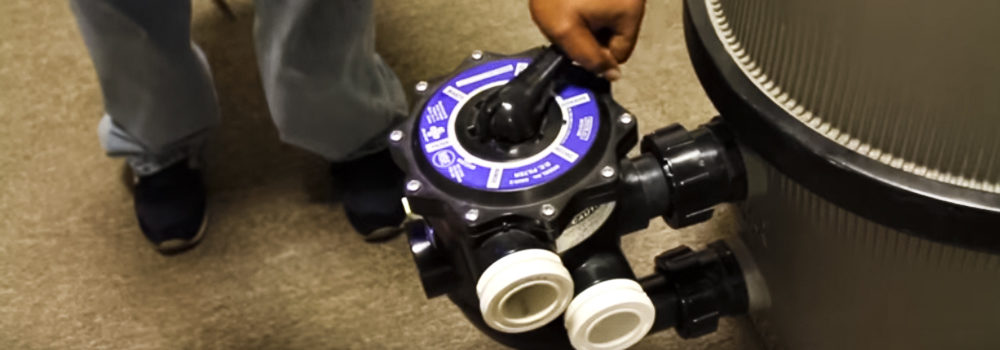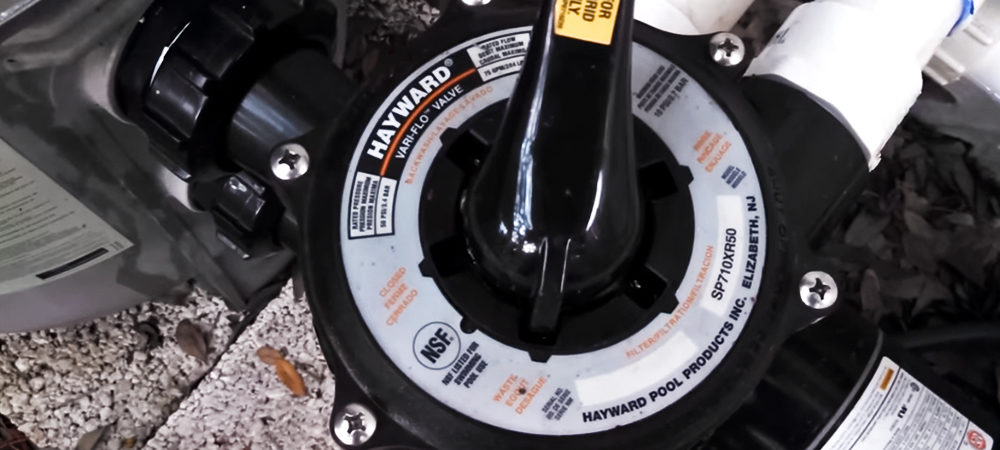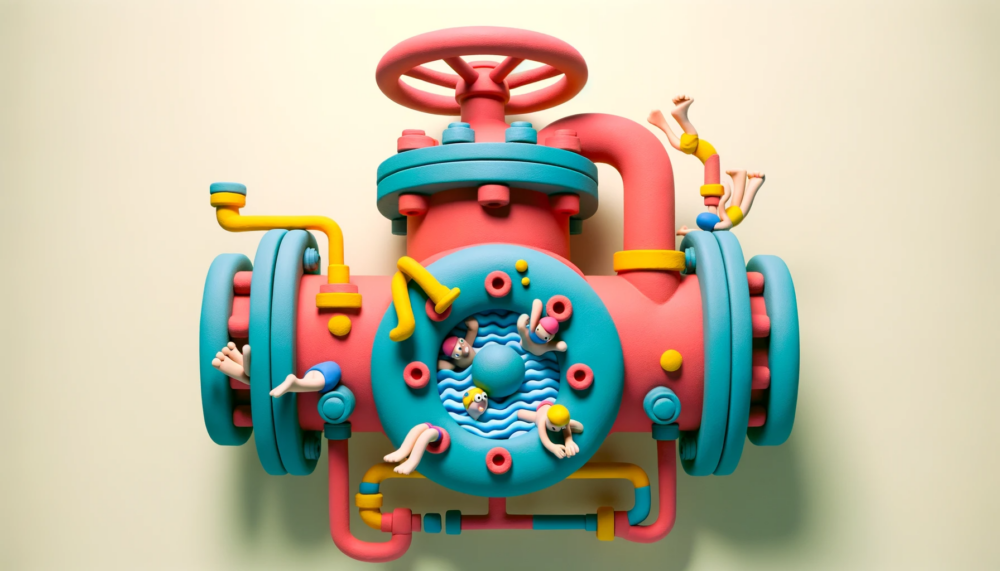Sand and diatomaceous earth pool filters offer many benefits, including durable and inexpensive filtration media, user-friendly operation and an easy backwashing process. These pool filters are equipped with a multiport valve that diverts the water in different directions with the press and turn of a handle.

While other types of valves exist, they do not offer the level of pool-maintenance flexibility as opposed to multiport valves. Unfortunately, multiport valves don’t always last throughout the filter’s life. Leaks can occur at many connection points within the valve or between the valve and the filter tank.
Using a filter when its valve isn’t functioning properly will make the pool water unhygienic, and it can spell expensive disaster down the road. Sometimes, malfunctions can be easily repaired. Other times, a replacement makes more sense. That is why we added a troubleshooting section in our buyer’s guide.
We also included information for first-time DE/sand filter users in our multiport valve buyer’s guide. If you’ve never owned a sand or a diatomaceous earth filter, you need to know what each setting means and when that setting should be engaged. There are usually six positions, but some valves have an extra winterizing setting.
This website is supported by readers. As an Amazon Associate we earn from qualifying purchases.
Best Pool Multiport Valves
Compared to push-pull and diverter-style valves, multiport valves offer the greatest number of settings. When choosing a multiport valve for your diatomaceous earth or sand filter, you have to make sure it’s sized to fit the tank. Also important are the valve’s mount location and the warranty. Take a look at these multiport valves on our review list.
Pool Multiport Valve Buying Guide
If you have a filter that uses DE or sand, it will have a multiport valve on its side or top. Like all other mechanical parts, the multiport valve will eventually fail. Sometimes, breakdowns can be fixed. Other times, it makes more sense to replace the valve instead of repair it.

Our buyer’s guide focuses on making sense of each setting – Yours may come with up to seven positions, some of which you’ll use more often than others. We also discuss common multiport valve issues and how to troubleshoot them. Should you decide that a replacement is in order, read our step-by-step instructions on how to install a new one.
Commonly Used Multiport Valve Settings
As the normal setting, filter is the one you’ll need to use the most. When in this position, the water runs through the pump port and travel down the sand and diatomaceous earth to capture pool debris. Then, the now-clean water exits through the return port. We also recommend using the filter setting while vacuuming.
The backwash position should be used when the filter is overloaded with debris. A 7 to 10 psi rise will indicate the need for backwashing. On this setting, the water moves backward, exiting from the waste port and taking debris buildup along with it. Backwashing takes 5 minutes tops.
Anytime you backwash a filter, you must rinse it, which you can do via the filter’s dedicated rinse setting. When set to rinse, the water flows from top to bottom just as it does in filter mode. However, the water is directed to the waste port instead of the return port that leads to the swimming pool.
Infrequently Used Multiport Valve Settings
There are several reasons to position the multiport valve to the waste setting – when lowering the water level, dealing with an overfilled pool, treating the water for algae and vacuuming extra-fine sediment. After you set the valve to waste, the water from the pool enters the pump port, and it’s released through the waste port, bypassing the filter.

Recirculate is another valve position that bypasses the sand or DE filter. On recirculate, sometimes simply called bypass, water is sent through the pump port and leaves through the return port without undergoing the filtration process. Reasons to use the recirculate setting include adding certain pool chemicals and circulating the water in the event the filter becomes damaged.
Closed is a rarely used setting. The only times you’ll need to set the filter to closed are when you’re servicing the swimming pool’s pump or winterizing the suction lines. The closed position halts the water flow at the filter’s pump port. Before you turn the valve handle to closed, make sure the pool pump is not running.
Some multiport valves do not have a winter setting because it accomplishes a similar goal as the closed position does. However, the winter position also takes tension off the valve’s internal spring and holds the valve above the ports, preventing breakdowns from prolonged non-use and cracks from frozen water.
Troubleshooting: Stuck Handle
Moving mechanical parts wear out from time to time. It’s not uncommon for a multiport valve’s handle to become difficult or impossible to turn. When this happens, you’ll need to take apart the valve, clean the parts and lubricate them.
Troubleshooting: Handle and Cover Leaks
If you see water pushing up to the top of the valve and flowing over the lid, the likely culprit is a handle leak. The cause of a handle leak is often due to an out-of-whack or failing O-ring gasket, which happens with repeated exposure to cold weather and water. Sometimes, stuck particles are the cause.

Elevated pressure can cause leaks elsewhere, particularly at the valve cover. First, examine the cover’s screws and tighten any loose ones. If that doesn’t stop the leak and the pressure is still high, make sure the filter isn’t dirty. If all else fails, you’ll need to unscrew the valve cover and replace its gasket.
Troubleshooting: Gauge and Port Leaks
Gauge leaks are usually a problem that occurs in top-mounted multiport valves and characterized by trickling water coming from below the gauge. A cracked valve body, stripped plastic threads or multiple layers of Teflon tape are the cause. Once you’ve determined the source, you need to glue the crack, thread in an insert or remove and replace the tape.
All multiport valves have a waste, return and pump port. Often, leaks happen due to a too-tight adapter. On some occasions, a shrunken PVC connector or sagging pipes can lead to a leakage. You can fix this type of leak by replacing the PVC pipe and fittings. If the valve body becomes cracked, a valve replacement is in order.
Troubleshooting: Tank Connection and Waste Line Leaks
Depending on the multiport valve’s mount location, the leak may be originating from the flange area or the bulkhead area. Bulkhead leaks happen on side-mounted valves while flange-centric leaks occur on top-mounted multiport valves. Most leaks can be repaired, but those that come from between the tank and flange necessitate a full valve replacement.
The waste port can be particularly problematic. If you see water coming from this port when the filter isn’t set to backwash, there’s a leak. Any number of reasons could cause a waste-port leak, such as the spider gasket or the key assembly spring. To pinpoint either cause, you must disassemble the multiport valve. However, replacing it is easier.
FAQs
Can I Change the Handle Position While the Filter is Running?
You should always turn off the filter before you adjust the multiport valve’s position. When the filter is on, water is moving through it, and the pressure generated by that water is quite high. If you turn the handle while the filter is running, that pressure could cause the gasket to break and water to leak or even gush.

How Do I Remove an Old Multiport Valve?
Multiport valves don’t last forever – Most provide 5 to 7 years of working life. When an aging or irreparable valve needs to be replaced, you must first turn off the pump and set the valve to closed. Then, you need to drain the water by pulling the filter’s drain plug.
After the water is drained, grab a pair of PVC cutters and cut the inlet and outlet, leaving about a 6-inch gap between the pipes and the valve ports. Then, you can unscrew the bulkhead unions (side-mounted valve) or remove the clamp (top-mounted valve). Finally, you can take off the old valve and install the new one.
Do Cartridge Filters Come With a Multiport Valve?
Pool filters come in sand, diatomaceous earth and cartridge varieties. A multiport valve’s main function is to clean the sand or DE inside the filter. Cartridges in a cartridge filter are removable, and you clean those by simply rinsing them with a water hose. Therefore, cartridge filters do not need nor require a multiport valve.

Pool Multiport Valves: Recap
The multiport valve plays a crucial role in the operation of a sand or a diatomaceous earth filter by keeping the water flowing in the proper circulation sequence or stopping the flow altogether. It manages to do so by changing the flow direction when you turn the handle to one of its six or seven settings.
Although the valve’s handle can get stuck in place from time to time, the most common malfunction is a leak. On a multiport valve, the leak can occur in a multitude of areas. For instance, the valve can spring a leak at one of its three ports or gauge. Leaks may also originate from the filter cover connection.
Without a working multiport valve, the filter can’t clean your pool’s water and the filter itself may become damaged beyond repair. There are some breakdowns you can repair yourself, but not all leak sources are fixable. For those that aren’t repairable, a full replacement is in order. Luckily, valve removal and installation are DIY kinds of project.
Before buying a multiport valve, make sure it’s designed for use on your filter. It must also be made to mount to the appropriate location whether that be the top or the side. Like most items you buy for long-term use, make sure to the valve comes with a comprehensive warranty.





